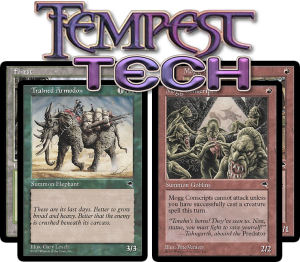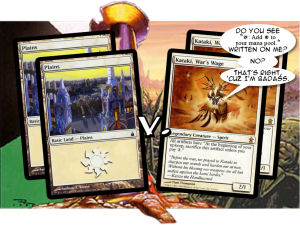I think that you have probably got too many land in your beatdown deck. Today I want to tell you why this is the case (unless you are from Japan), and how this information might help you built better decks in the future.
The idea for this article came from Antonino De Rosa’s article last week on Another Magic Webite which I used to write for. I don’t agree with Antonino in the argument that he makes, but an acknowledgement is only fair.
In his article, he looked at the difference between the Japanese Boros Deck Wins decks at the last Extended Pro Tour, and the other successful Boros and Red Deck Wins in the Top 8.
The main difference which he identified was that the Japanese deck has 21 land, and the other decks have 23. It might not sound like a big difference, but across the course of a tournament, it is statistically significant and games can be won or lost on the difference between having two land fewer or more in your deck. More interestingly for those who don’t like statistics is the effect it has on deck construction. Whenever any of us build a deck, there are always more cards that we want to fit in than there is space available, and agonising about which cards to leave out occupies, on average, three entire days of the average deckbuilder’s life. Two fewer land in your deck means two more burn spells or Goblins or something cool like that.
[A brief aside – I have chosen not to write about how the exact percentage probability changes if you add or remove a land from your deck, because my experience is that many people are put off by paragraphs of calculations, and those that are not are easily capable of doing the calculations for themselves. If you want to know the exact numbers, ask me in the forums, if not, then read on…]
The only problem is that conventional Magic theory says that it is better to have 23 than 21 land for this kind of deck. The reason for this is that aggressive decks need consistency. The Japanese Boros Deck has eight land destruction cards. The threat of playing a creature on the first turn, a creature on the second turn and then a Molten Rain or Pillage on the third turn is a powerful one. But with only 21 land, there will be some games during the course of a tournament when you will not draw three land by turn 3, and therefore be stuck with these cards in your hand. Having twenty one land also makes it more likely, although only marginally, that you will be stuck with no White mana to cast Isamaru on the first turn, or (horror of horrors) not enough Red mana to use your burn spells when you most need to.
Aggressive decks also need to get off to a good start. More defensive decks can sometimes take more time to develop their position, but if a deck like Boros Deck Wins is stuck without the right mana to play its cards in the first two or three turns, then the control decks will have time to get their more expensive but more powerful cards online.
Related to this is the fact that if two different aggressive decks face off, it is often the deck which has more land and more ability to cast expensive spells which wins. If you compare the Japanese deck to Ervin Tormos deck, for example, both have Fledgling Dragon which they would bring in when facing each other. If one deck gets to cast its Dragon while the other is stuck on two or three land, then that will usually decide the winner of the game.
This preference for consistency in being able to make early land drops is deeply rooted in the way of the Red Deck. The original Extended version of Red Deck Wins actually had 24 land, one more even than Tormos’s deck. But I don’t think that it is an adequate explanation to say that Tsuyoshi and his teammates made a mistake and got lucky. Where successful decks contradict theory, it is nearly always the theory which is wrong, not the deck. Various explanations for why the Japanese chose to play with fewer land have been advanced, of which my favorite is:
“Maybe their numbers wouldn’t seem to normally work, but maybe they work against OUR numbers. Maybe they’ve hit on something Westerners can’t understand, some sort of Zen thing (yes, yes I know Zen isn’t really a Japanese concept, but bear with me).“
…
I think Randy Buehler has a better answer.
Back when Randy was a professional Magic player, he made a Green Deck with Slivers and played it at a Pro Tour in Los Angeles. He did very well, too, and made the Top 16, along with his teammate and now fellow Wizards employee Brian Schneider. This was nearly as good as the performance of the Red Deck, which put five people in the Top 8, including Dave Price, the overall winner and King of Beatdown.
Before the tournament, Randy thought that the Green Deck was simply better than the Red Deck. Its creatures were bigger, and with Skyshroud Ranger and Ancient Tomb, it had the ability to power them out to keep up with the Moggs. It also had four Cursed Scrolls, giving it the power to match Red’s capability to deal direct damage and remove creatures. He would be able to match the Red Decks 1/1s and 2/2s with 2/2s and 3/3s, and be able to play them just as quickly.

There was just one problem. To be able to do all of this, the deck needed 25 lands, whereas the Red Deck only needed 20. So the Green deck could gain card advantage by, say, trading a Trained Armodon for a Mogg Conscripts and a Mogg Raider (or, to use the modern as opposed to archaic names, a Gnarled Mass for a Goblin Cohort and a Goblin Sledder). But the problem was that the Red Deck would be more likely to topdeck creatures than the Green Deck, and beyond the first three or four land, neither deck had much use for extra land. In his report after the tournament, Randy explained that this was something that he had missed before the tournament, and which explained why his deck didn’t have a favourable matchup against the most popular and best deck in the field. Here ends the Tempest only Constructed Tech section.
Obviously, the difference between 25 and 20 land is much greater than the example of 23 and 21 from the different versions of Boros Deck Wins, but the principle is the same. Against many decks, Boros Deck Wins will succeed in getting its opponent to a low life total with creature attacks, and then rely on burn spells to finish the job. There is often a two or three turn window in which the deck needs to topdeck a burn spell or Goblin Legionnaire to win the game before you get killed. Tsuyoshi had a better chance of drawing a relevant card at this stage of the game than the Boros Deck Wins players who had more land in their deck.
Indeed, in the Top 8 Tsuyoshi actually went further than this by sideboarding out three land against Antoine Ruel. It didn’t work in the actual match, but most players wouldn’t even have tried it. The best chance he had was to draw only two or three land and for every other card to be a creature or burn spell. So he increased the probability of that happening.
Part of the aversion to playing with fewer lands in your deck is that it feels worse when you lose because you keep a one land hand and don’t draw another until turn five then when you keep a four land hand, draw twice as many spells as land during the course of the game and die on turn fifteen with eight land in play because your opponent was just about able to remove all of your threats. It may seem like your deck worked better in the second example, and it is more fun to be able to cast your spells and interact rather than sit there and discard. From the point of view of winning games, optimising your deck to consistently produce the same kind of start is only a good idea if it is likely that that start will win you a decent proportion of games played.
The trade off between increasing the number of threats in your deck and having more mana to make the deck work more consistently is one of the most interesting and difficult bits of making a deck. This article isn’t about which way of building the Boros Deck in Extended was three months ago, but about how you should go about building and tuning decks in the future, whether you are playing Extended, Standard, Limited, casually or whatever. The bit which is relatively well known is that if you find that your deck isn’t working because you keep on not being able to draw enough land to cast your spells before your opponent kills you, then you need to put more land in your deck. Lots of people do that all the time, and it is the way of improving most decks.

However, what you can learn from the Japanese is that if you find that you are getting the mana that you need to cast your spells, but that you often can’t quite finish your opponent off, or that you finish games with many more land in play then your deck could make use of, then do the opposite to the above procedure. Take land out of your deck and add in cards which complement your deck or which are devastating against the deck you are expecting to face most of or which gives you most trouble. If Affinity is expected to be the most popular deck, for example, playing with fewer lands and fitting in maindeck copies of Kataki will mean that you lose a couple more games to mana screw, and win a whole load more games by playing a completely devastating card on turn 2 of game one.
This also applies to sideboarding. It is usually really bad to sideboard out land, but this is not part of the Comprehensive Floor Rules – you won’t get a judge coming up and giving you a warning if you do. And if your testing has shown that against this particular deck then you would do better with fewer land and more creatures (say), then make that swap.
I hope that’s been helpful. I never quite know when writing Magic strategy whether what I’m saying is obvious, but I think that it is a useful exercise to look at how the decks and strategies of the best players work, not from the point of view of making accusations of being lucky or dishonest, or by ascribing it to “their numbers working differently”, but instead using their success to challenge assumptions about the right way to build decks and learning how to get better as a result.
Until next time, may you not draw a Plains when what you really wanted was a Goblin,
Take care,
Dan Paskins
P.S. Like everyone else I think Ted ought to stay as editor here foreverandeverandever, but nonetheless I’d like to wish Ted all the best in his new job – I’ve instructed the Goblins infiltrating R&D to make him feel welcome and help out by answering any questions and fetching stuff. I have also told them that they are not to be mean by going into his computer and adding random paragraphs of their own work on weird decklists and musings on the nature of Elegance to his writers’ articles like they did while Scott Johns was editor.
